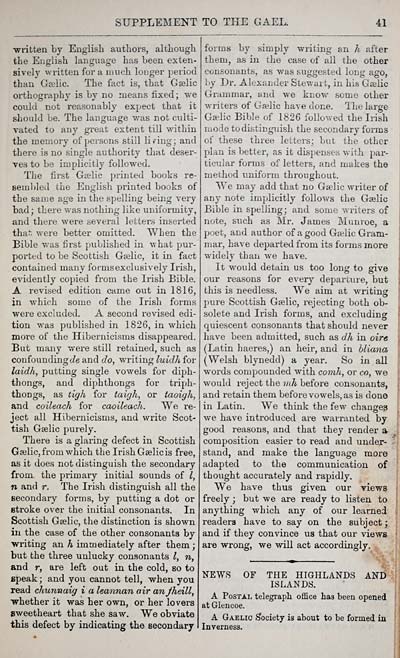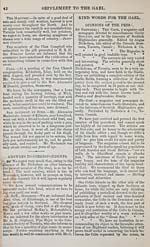Hew Morrison Collection > Gaidheal > 1 Leabh 2 Air
(35)
Download files
Complete book:
Individual page:
Thumbnail gallery: Grid view | List view

SUPPLEMENT TO THE GAEL.
41
•written by English authors, although
the English language has been exten-
sively vvritten for a much longer period
than Gselic. The fact is, that Gajlic
orthography is by no means fixed ; we
could not reasonably expect that it
should be. The language was not culti-
vated to any great extent till within
the memory of persons still lining; and
there is no single authority that deser-
ves to be implicitly followed.
The first Gnelic printed books re-
sembled the English printed books of
the same age in the spelling being very
bad; there vv'as nothing like uniformity,
and there were several letters inserted
tha^ were better omitted. When the
Bible was first published in what pur-
ported to be Scottish Gaslic, it in fact
contained many formsexclusively Irish,
evidently copied from the Irish Bible.
A revised edition came out in 1816,
in which some of the Irish forms
were excluded. A second revised edi-
tion was published in 1826, in which
more of the Hibernicisms disappeared.
But many were still retained, such as
confounding c/e and do, writing luidh for
laidh, putting single vowels for diph-
thongs, and diphthongs for triph-
thongs, as tigh for taigh, or taoigh,
and coileach for caoileach. We re-
ject all Hibernicisms, and write Scot-
tish Gaelic purely.
There is a glaring defect in Scottish
Gaelic, from which the Irish Gaelic is free,
as it does not distinguish the secondary
from the primary initial sounds of I,
n and r. The Irish distinguish all the
secondary forms, by putting a dot or
Btroke over the initial consonants. In
Scottish Gaelic, the distinction is shown
iu the case of the other consonants by
writing an h immediately after them ;
but the three unlucky consonants I, n,
and r, are left out in the cold, so to
speak ; and you cannot tell, when you
read chunnaig i a leannan air anjhdll,
"whether it was her own, or her lovers
sweetheart that she saw. We obviate
this defect by indicating the secondary
forms by simply writing an h after
them, as in the case of all the other
consonants, as was suggested long ago,
!iy Dr. Alexander Stewart, in his Gaelic
Grammar, and we know some other
writers of Gaelic have done. The lai'ge
Gaelic Bible of 1826 followed the Irish
mode to distinguish the secondary forms
of these three letters; but the other
plan is better, as it dis])enses with par-
ticular forms of letters, and makes the
method uniform throughout.
We may add that no Gaelic writer of
any note implicitly follovv^s the Gaelic
Bible in spelling; and some Avriters of
note, such as Mr. James Munroe, a
poet, and author of a good Gaelic Gram-
mar, have departed from its forms more
widely than we have.
It would detain us too long to give
our reasons for every departure, but
this is needless. We aim at Avriting
pure Scottish Gaelic, rejecting both ob-
solete and Irish forms, and excluding
quiescent consonants that should never
have been admitted, such as dh in oire
(Latin haeres,) an heir, and in hliana
(Welsh blynedd) a year. So in all
words compounded with comh, or co, we
would reject tlie mh before consonants,
and retain them before vowels, as is done
in Latin. We think the few changes
we have introduced are warranted by
good reasons, and that they render a
composition easier to read and under- -
stand, and make the language more
adapted to the communication of
thought accurately and rapidly.
We have thus given our views
freely ; but we are ready to listen to '"
anything which any of our learned
readers have to say on the subject ;
and if they convince us that our views
are wrong, we will act accordingly.
NEWS OF THE HIGHLANDS AND
ISLANDS.
A Postal telegraph office has been opened
at Glencoe.
A Gaelic Societj is about to be formed in
Inverness.
41
•written by English authors, although
the English language has been exten-
sively vvritten for a much longer period
than Gselic. The fact is, that Gajlic
orthography is by no means fixed ; we
could not reasonably expect that it
should be. The language was not culti-
vated to any great extent till within
the memory of persons still lining; and
there is no single authority that deser-
ves to be implicitly followed.
The first Gnelic printed books re-
sembled the English printed books of
the same age in the spelling being very
bad; there vv'as nothing like uniformity,
and there were several letters inserted
tha^ were better omitted. When the
Bible was first published in what pur-
ported to be Scottish Gaslic, it in fact
contained many formsexclusively Irish,
evidently copied from the Irish Bible.
A revised edition came out in 1816,
in which some of the Irish forms
were excluded. A second revised edi-
tion was published in 1826, in which
more of the Hibernicisms disappeared.
But many were still retained, such as
confounding c/e and do, writing luidh for
laidh, putting single vowels for diph-
thongs, and diphthongs for triph-
thongs, as tigh for taigh, or taoigh,
and coileach for caoileach. We re-
ject all Hibernicisms, and write Scot-
tish Gaelic purely.
There is a glaring defect in Scottish
Gaelic, from which the Irish Gaelic is free,
as it does not distinguish the secondary
from the primary initial sounds of I,
n and r. The Irish distinguish all the
secondary forms, by putting a dot or
Btroke over the initial consonants. In
Scottish Gaelic, the distinction is shown
iu the case of the other consonants by
writing an h immediately after them ;
but the three unlucky consonants I, n,
and r, are left out in the cold, so to
speak ; and you cannot tell, when you
read chunnaig i a leannan air anjhdll,
"whether it was her own, or her lovers
sweetheart that she saw. We obviate
this defect by indicating the secondary
forms by simply writing an h after
them, as in the case of all the other
consonants, as was suggested long ago,
!iy Dr. Alexander Stewart, in his Gaelic
Grammar, and we know some other
writers of Gaelic have done. The lai'ge
Gaelic Bible of 1826 followed the Irish
mode to distinguish the secondary forms
of these three letters; but the other
plan is better, as it dis])enses with par-
ticular forms of letters, and makes the
method uniform throughout.
We may add that no Gaelic writer of
any note implicitly follovv^s the Gaelic
Bible in spelling; and some Avriters of
note, such as Mr. James Munroe, a
poet, and author of a good Gaelic Gram-
mar, have departed from its forms more
widely than we have.
It would detain us too long to give
our reasons for every departure, but
this is needless. We aim at Avriting
pure Scottish Gaelic, rejecting both ob-
solete and Irish forms, and excluding
quiescent consonants that should never
have been admitted, such as dh in oire
(Latin haeres,) an heir, and in hliana
(Welsh blynedd) a year. So in all
words compounded with comh, or co, we
would reject tlie mh before consonants,
and retain them before vowels, as is done
in Latin. We think the few changes
we have introduced are warranted by
good reasons, and that they render a
composition easier to read and under- -
stand, and make the language more
adapted to the communication of
thought accurately and rapidly.
We have thus given our views
freely ; but we are ready to listen to '"
anything which any of our learned
readers have to say on the subject ;
and if they convince us that our views
are wrong, we will act accordingly.
NEWS OF THE HIGHLANDS AND
ISLANDS.
A Postal telegraph office has been opened
at Glencoe.
A Gaelic Societj is about to be formed in
Inverness.
Set display mode to: Large image | Transcription
Images and transcriptions on this page, including medium image downloads, may be used under the Creative Commons Attribution 4.0 International Licence unless otherwise stated. ![]()
| Early Gaelic Book Collections > Hew Morrison Collection > Gaidheal > 1 Leabh 2 Air > (35) |
|---|
| Permanent URL | https://digital.nls.uk/76795560 |
|---|
| Attribution and copyright: |
|
|---|---|
| Description | A selection of items from a collection of 320 volumes and 30 pamphlets of literary and religious works in Scottish Gaelic. From the personal library of Hew Morrison, the first City Librarian of Edinburgh. |
|---|
| Description | Selected items from five 'Special and Named Printed Collections'. Includes books in Gaelic and other Celtic languages, works about the Gaels, their languages, literature, culture and history. |
|---|

